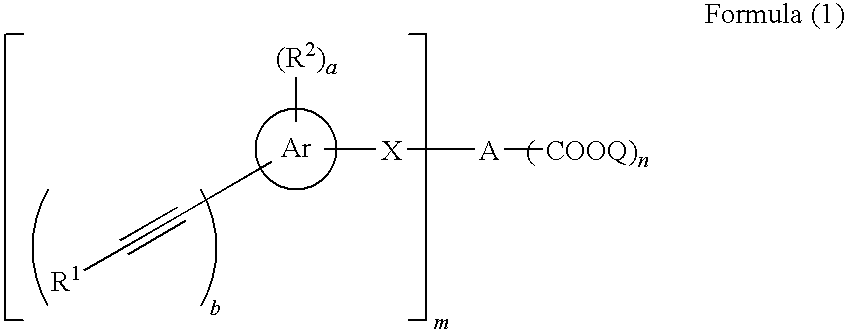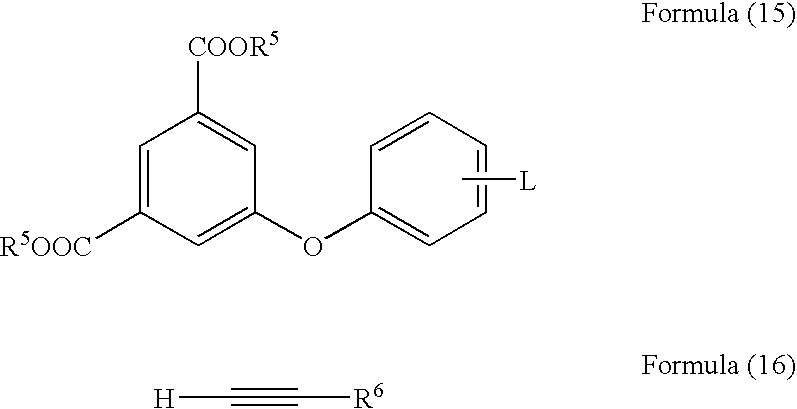Acetylene compound
a technology of acetylene compound and compound, applied in the field of acetylene compound, can solve the problems of narrow selection of materials as the subject of research relating to functional materials, compound may not be obtained with sufficient yield, and no example of compound having plural carbon-carbon triple bond structur
- Summary
- Abstract
- Description
- Claims
- Application Information
AI Technical Summary
Benefits of technology
Problems solved by technology
Method used
Image
Examples
example 1
[0230]Exemplary Compound (1)-64 was synthesized according to the following Formula:
[0231]To a 3000 mL three-necked flask, were introduced 63 g of 5-aminoisophthalic acid and 600 mL of N-methyl-2-pyrrolidone, and the mixture was stirred until the solute was completely dissolved. To a 500 mL conical flask, were introduced 60 g of 5-ethynyl isobenzofuran-1,3-dione and 600 mL of N-methyl-2-pyrrolidone, and the mixture was stirred until the solute was completely dissolved, thereby forming a dropping liquid 1. The dropping liquid 1 was added dropwise using a dropping funnel over 15 minutes to the mixture in the 3000 mL three-necked flask, with stirring continuously, and the resultant mixture was heated to 40° C. and was stirred continuously for 4 hours.
[0232]After the flask was cooled to room temperature, a liquid in which 2.8 g of pyridine was dissolved in 20 mL of N-methyl-2-pyrrolidone was added to the 3000 mL three-necked flask, subsequently, a mixed liquid of 153 g of acetic anhydrid...
example 2
[0235]Exemplary Compound (1)-63 was synthesized according to the following Formula:
[0236]Exemplary Compound (1)-64 was neutralized in an aqueous hydrochloric acid solution prepared from 175 mL of concentrated hydrochloric acid and 1000 mL of ion exchanged water, thereby obtaining crude crystals of Exemplary Compound (1)-63. The crude crystals were washed with 1000 mL of ion exchanged water, and were filtrated off. The filtered product was introduced into a 3000 mL three-necked flask, and was dissolved in 1800 mL of N-methyl-2-pyrrolidone. To the solution was added dropwise a mixed liquid of 210 mL of acetonitrile and 490 mL of ion exchanged water using a dropping funnel over one hour, thereby precipitating Exemplary Compound (1)-63. The crystals were washed with 500 mL of acetonitrile and filtrated off, thereby obtaining 45 g of the aimed Exemplary Compound (1)-63 (yield; 61%).
[0237]MS:M+=335.04
[0238]1H-NMR (400 MHz, DMSO-d6): δ=12.79 (s, 2H), δ=8.85 (s, 2H), δ=8.34 (s, 1H), δ=8.29 ...
example 3
[0239]Exemplary Compound (1)-67 was synthesized according to the following Formula:
[0240]To a 2000 mL three-necked flask, were introduced 63 g of dimethyl 5-aminoisophthalate and 200 mL of N-methyl-2-pyrrolidone, and the mixture was stirred until the solute was completely dissolved. To a 500 mL conical flask, were introduced 52 g of 5-ethynyl isobenzofuran-1,3-dione and 400 mL of N-methyl-2-pyrrolidone, and the mixture was stirred until the solute was completely dissolved, to form a dropping liquid 2. The dropping liquid 2 was added dropwise using a dropping funnel over 15 minutes to the mixture in the 2000 mL three-necked flask, with stirring continuously, and the resultant mixture was heated to 40° C. and was stirred continuously for 4 hours.
[0241]After the flask was cooled to room temperature, a liquid, in which 2.4 g of pyridine was dissolved in 20 mL, was added to the 2000 mL three-necked flask, subsequently, a mixed liquid of 101 g of acetic anhydride and 100 g of N-methyl-2-p...
PUM
| Property | Measurement | Unit |
|---|---|---|
| temperature | aaaaa | aaaaa |
| temperature | aaaaa | aaaaa |
| temperature | aaaaa | aaaaa |
Abstract
Description
Claims
Application Information
 Login to View More
Login to View More - R&D
- Intellectual Property
- Life Sciences
- Materials
- Tech Scout
- Unparalleled Data Quality
- Higher Quality Content
- 60% Fewer Hallucinations
Browse by: Latest US Patents, China's latest patents, Technical Efficacy Thesaurus, Application Domain, Technology Topic, Popular Technical Reports.
© 2025 PatSnap. All rights reserved.Legal|Privacy policy|Modern Slavery Act Transparency Statement|Sitemap|About US| Contact US: help@patsnap.com



